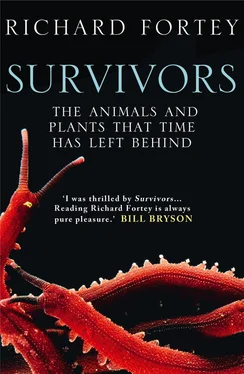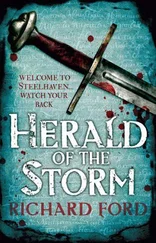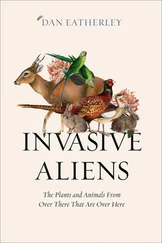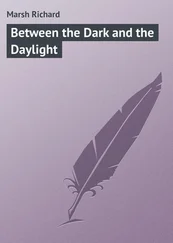Up on the shore are some dead stromatolites, left behind by the sea maybe a thousand years ago. By now they have decayed into iron-stained ruins, but where they have broken open they show the internal structure of the cushion-shaped columns. It is clear to me that the columns are layered internally parallel to their top surfaces, rather like filo pastry. They seem to be built up layer by layer – a little like those giant stack pancakes an unwary visitor gets offered in New York for breakfast. The columns were evidently living things, self-made towers. A little museum on the site of the old telegraph office nearby provides more explanation. I peer closely at a stromatolite kept in a glass tank; its enveloping seawater must be refreshed every month. I see that when water covers the column its surface is slightly fuzzy – no doubt, it is still alive. A lack of crisp definition is somehow a proof of metabolism in action, life blurring the edges. Little bubbles fizz upwards off the top in a steady stream, none bigger than a lentil: they are bubbles of oxygen. So the column is evidently more than a brownish crust, it is something altogether more potent and dynamic, and it is breathing out oxygen, the element that babies and bilbies and bunnies all need to stay alive. Everyone has had nightmares about suffocation, when fighting for breath becomes fighting for life, so we all know in our bones how quickly we would perish without oxygen. The exhibition reminds me of the demonstration of nature in action at my very first school, when us kids looked at water-weed in a full glass beaker, and saw the same little bubbles of oxygen rising to the surface. This was the first time I heard the word ‘photosynthesis’.
The survival of the stromatolites on the beach is another measure of their toughness. On the foreshore I see two broad grooves carving their way through the stromatolite grove. These are the persistent traces of a former industry. In the late nineteenth and early twentieth century, camel trains brought bales of wool here to Flagpole Landing. These were then carted off the foreshore to lighters that sailed 190 kilometres to a boat waiting in deep anchorage off Dirk Hartog Island. Then the wool was transported to Fremantle and finally to the United Kingdom for manufacturing. We are fortunate that these activities did not destroy the mounds completely. But it is also a measure of the slow rate of biological activity hereabouts that the old tracks are still visible after a century.
Sea conditions in this part of Shark Bay are quite particular. The shallow seawater evaporates fast under the relentless sun. It is the basis of a salt industry at Useless Loop nearby. The very clear water has an elevated salinity and is very poor in nutrients. Hamelin Pool is backed up behind a sand bar known as Fauré Island, lying about forty-seven kilometres out to sea, so it is almost a lagoon. Only specially adapted or tolerant organisms can survive under these conditions. One of those animals is a little clam called Fragum hamelini, which, as the name implies, is special to this locality. It is so abundant that its snow-white shells, none bigger than a walnut, make up the dunes that line the Bay. After some decades the shells harden into a shelly rock – it would be an exaggeration to call it a limestone. An old quarry above the shore records the employment into which this curious white stone has been pressed. Cut into blocks the size of large bricks it made a serviceable, if hardly robust building stone. Some of the older edifices made of it still stand. The stone was used to build the walls of the Pearler Inn in the town of Denham, eighty kilometres distant. This pub looks as if it were constructed from a mass of white peas. In order to survive the testing conditions in the Bay, Fragum has incorporated photosynthesising algae into its tissues: sunlight is the ultimate source of its food, just as it is for the stromatolites. But Fragum is an evolutionary newcomer, whereas the stromatolites are very, very ancient.
Stromatolites are mounds slowly built up by microscopic organisms, layer by layer. The mounds are not composed of a single organism: they are a whole ecology. The tacky or slimy skin that caps the stromatolites is the living part. This very thin layer is composed mostly of cyanobacteria, organisms that are often called ‘blue greens’ (or, formerly and incorrectly, blue-green algae) on account of their characteristic hue beneath the microscope. This may well explain why I expected the stromatolites to be green. The conditions in Hamelin Pool suit their growth. There are many organisms in nature that like to graze on ‘blue greens’. Think of those finely scalloped trails wandering over moist rocks by the seaside, made by the rasping action of the sea snail’s feeding apparatus as it scrapes away the thin nutritious bacterial layer that paints the rocky surface. This is not inappropriately compared with grazing by herbivores on terrestrial environments. Like grass, the ‘blue greens’ grow back, and the molluscs move on. But these micro-organisms never have the chance to build complex or elaborate structures like mounds or ‘stagshorns’ because the constant assault of herbivores renders their best attempts at architecture futile. Everything is eaten back before it can grow too big. However, in the special, warm world of Hamelin Pool the grazers are kept at bay. No snails sully the sticky surfaces of the stromatolites; the fish there don’t nibble away the ‘blue greens’ for supper; in fact, nothing much ventures into the almost unnaturally limpid seas. Some authorities believe that the very low nutrient levels in the Pool are as important in growing stromatolites as the absence of grazers. Whatever the reason, the simple organisms have it all their own way for once. And when they do, they reconstruct the Precambrian world. This is how life was before marine animals chomped and scraped away ancient biological constructions that had covered much of the sub-aqueous environment since life began. In Shark Bay a prelapsarian age can be restored to view, a time before velvet worms or even vendobionts, or anything that crawled upon its belly in the mud. I have seen dozens of artist’s reconstructions of ancient seascapes that owe a debt to the prospect at Hamelin Pool. So when I saw the living stromatolites I was not unprepared for the experience. However, I recall seeing Picasso’s Guernica for the first time; just because an image is familiar does not diminish the impact of the real thing.
Cyanobacteria are simple organisms that often make long, green and narrow threads with organic walls which can be as thin as a few thousandths of a millimetre, but which often occur in sufficient profusion to make green slime. Other species are tiny round cells that grow by fission – essentially splitting in two, to double up as identical twins. They are ubiquitous. When a glass of water is left in the light on a window ledge, cyanobacteria will usually appear as a green smudge. They have been wrongly called ‘blue-green algae’ in old textbooks, but as we shall see the algae are altogether more complicated organisms. When raindrops wash over rocks in a desert these tiny organisms will soon take advantage of the opportunity to grow, and the rocks will shortly glisten with microscopic life. In the sea, their numbers occasionally erupt into ‘blooms’ of billions of cells that can poison fish, or even humans, if they eat the wrong kind of shellfish too soon after one of these events. In biological jargon the ‘blue greens’ are described as prokaryotes. They are both the smallest and the simplest-looking cells – often no more than a sphere or a sausage – but there are hundreds of different species. They lack an organised nucleus surrounded by a membrane that is present in every cell in what are termed eukaryotes. Every organism that has been mentioned so far in this book (including the author) is a eukaryote, which is another way of saying that our narrative has now arrived back to a simpler way of organising a living entity. Prokaryotes came before eukaryotes in time, which also means that they are closer to the main trunk of the tree of life. So there was a world before eukaryotes where the cyanobacteria were state-of-the-art and where the prospect before us in the shallow waters in one corner of Shark Bay would have been typical of much of the world, rather than a special survivor. I should flag up at this point that this prokaryote– eukaryote division is itself an over-simplification, and this topic will be revisited in the next chapter.
Читать дальше












